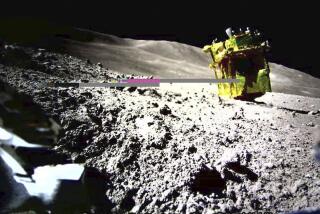Solar Max Drops From Orbit After Decade in Space
- Share via
The Solar Maximum Mission satellite, which was once repaired by the ill-fated space shuttle Challenger in a daring rendezvous 300 miles above the Earth, finally tumbled from space Saturday morning in a fiery re-entry over the Indian Ocean.
The 5,000-pound unmanned Solar Max entered the Earth’s atmosphere at 2:26 a.m. PST and disintegrated over a 500-mile-long band above the open sea between Australia and the coast of India.
The satellite fell about 45 minutes earlier than expected and well west of the predicted entry point over the Galapagos Islands, 1,300 miles west of Ecuador.
There were no reported sightings of the spacecraft as it streaked through the sky, although there was speculation that some of its larger parts, such as a door-sized, inch-thick titanium plate, could have survived the scorching descent.
“If it did, it’s at the bottom of the Indian Ocean,” said Capt. Thomas Niemann of the U.S. Space Command in Colorado Springs, Colo. “I think we’ve heard the last of Solar Max.”
The $80-million Solar Max was launched from Cape Canaveral by a Delta rocket on Valentine’s Day, 1980, on what was to have been a two-year mission to study solar flares, the sun’s atmosphere and its energy production.
The can-shaped Solar Max was launched near the height of the sun’s 11-year sunspot cycle, hence the name Solar Maximum Mission.
During its decade in space, Solar Max photographed more than 12,500 solar flares, took a quarter-million images of the sun’s corona and more than 100,000 ultraviolet images.
The satellite also discovered 10 sun-grazing comets and was the first to detect gamma rays from an exploding star in a nearby galaxy, helping scientists to confirm theories about how elements heavier than iron are forged in catastrophic supernova explosions.
Ten months after its launch, three fuses blew out on the satellite, leaving it incapable of precisely pointing toward specific areas of the sun.
The crew of the space shuttle Challenger conducted a daring repair of the satellite in 1984 that resembled a delicate ballet between two behemoths hurtling at more than 17,000 m.p.h. above the Earth.
On the first attempt to grab the satellite, a docking device malfunctioned and nearly sent Solar Max into a catastrophic tumble.
Two days later, the crew was successful in bringing Solar Max into the shuttle’s cargo bay, where the satellite was repaired and then sent back into orbit.
George (Pinky) Nelson, one of two shuttle astronauts who helped repair Solar Max, said in a telephone interview last week that he was saddened by the satellite’s demise.
“We were sure proud to get a chance to fix Solar Max,” he said. “I’m kind of sad to see it come back in but at the same time proud to have contributed to its mission. The last five years have been significant in terms of its scientific return.”
More to Read
Sign up for Essential California
The most important California stories and recommendations in your inbox every morning.
You may occasionally receive promotional content from the Los Angeles Times.











